Pee-wee’s Big Adventure was a foundational text—I’m guessing for a lot of us here—and there’s one scene in particular that seems to live on in people’s minds.
I am speaking, of course, of Large Marge.
In my experience, modern grief means running to the internet to make sure you’re not alone. Especially when you’re grieving someone you never met, but who changed your life just the same. Obviously yesterday the internet was flooded with memorials to Paul Rubens. Somewhere in the midst of my scrolling, I found this tweet from Nat Cassidy:
Large Marge sent me running out of the room, literally screaming, as a child. I was terrified of that face–that entire movie–for years afterwards. Decades, even.
As a horror writer I've been chasing that reaction ever since.
— Nat Cassidy, Social Media Ghost (Intermittent) (@natcassidy) July 31, 2023
And the more I thought about it the more I realized just how important this recognition is.
For most of its run time Pee-wee’s Big Adventure is a picaresque, a road movie that is both rollicking and a romp. Pee-wee loves his bike, his bike is stolen, and he has to use many non-bike modes of transport to find it and get it back. Pee-wee himself is of indeterminate age, bratty but goodhearted. He lives in a wonderland of a house with a dog but no parents; all the chores parents would normally either do themselves or force him to do are handled by Rube Goldberg contraptions. He hangs out with a crew of bike-riding pre-teens, eats Mr. T cereal for breakfast, and bickers with a rich snob named Francis who still lives in his dad’s mansion and plays with toys in his pool. When the two argue, Francis’ dad insists they make up like he’s forcing a pair of recalcitrant 10-year-olds to behave. The movie surrounds Pee-wee on all sides with sexual imagery and threats of adulthood—but, vitally, those threats are going to whoosh over the heads of most kids, and Pee-wee himself either doesn’t notice them or cheerfully ignores them.
It’s a Platonic ideal of ‘80s kids movie: silly, ridiculous and bright, with an anti-capitalist, anti-bully, pro-weirdo, queer-friendly, feminist, let’s-save-all-the-pets-in-the-burning-petshop-even-the-icky-ones message.
But there are two key scenes when the specter of the supernatural rears its sinister head.
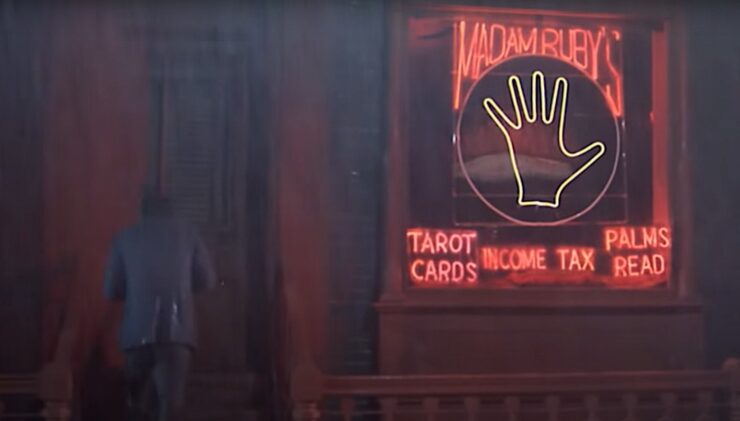
In the first, Pee-wee, staggers desolate through the rain until he finds a psychic. This is initially presented seriously: intense music, German Expressionist camera angles, Pee-wee’s shadow giving movie buffs a fun Nosferatu reference, Pee-wee himself so deranged by grief that his friends have (momentarily) abandoned him. The psychic’s shop seems to be the only business in this dark alley, and she welcomes him into her warm red-lit room.
Even as a kid I understood that Madame Ruby was scamming our hero. She demands cash, flips through his wallet to find significant details about his bike, and sends Pee-wee off on a quest cobbled together from slogans she sees outside her window.

The movie sets up the psychic as an obvious charlatan, and lets us in on the gag of her message to Pee-wee. Like all great kids’ movies, it gives you enough information to figure the joke out, and feel clever for doing so. But it lulls us into a false sense of reality. “Psychic powers are fake!” the movie assures us, and everything after bears this out, as Pee-wee is mocked and humiliated when he finally reaches the Alamo, and learns that Madame Ruby sent him on a goose chase.
But along the way he has a supernatural encounter that isn’t fake at all.
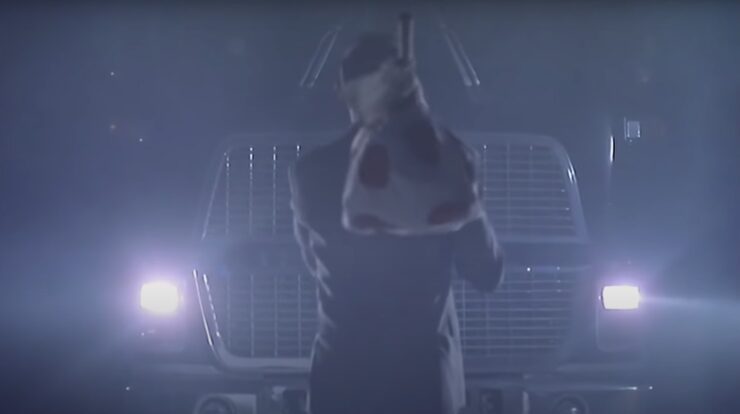
When Marge pulls up in her truck, we think she’s Pee-wee’s rescuer, here to save him from his night alone in the wilderness after Mickey ditches him in the middle of nowhere.
Marge seems at first to be another entry in the movie’s cavalcade of weirdos: she’s a female truck driver—which is already, for some of us, a tweak of gender roles and cool as hell (And I assume she inspired Hong Chau’s Marge in Poker Face, especially given that Natasha Lyonne got her start as a regular on Pee-wee’s Playhouse)—and she launches into what seems like a fun ghost story without even saying hello to Pee-wee, a thing that made total sense to Child Me.
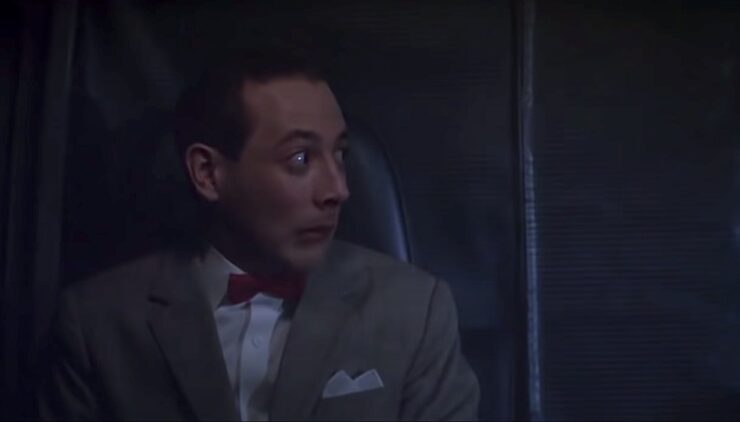
As Marge begins her tale of “the worst accident I ever seen” things get a little spookier, but, again, this is a kid-friendly scare. We hear that the sound of the crash was terrible, but the details are silly (it sounded like “a garbage truck dropped off the Empire State Building”) and rather than telling the audience the gruesome details of the wreck itself, the movie seems to cut to the very end of the story, after everyone’s dead.
Again, as freaky as it is, we think we’re safe—just a trucker telling ghost stories to her enthralled passenger. And then Marge turns and we see THIS:

Pee-wee himself reacts with fear, but not screaming terror or anything: he rolls with Large Marge’s ability to contort her face, and tells her to have a nice day when she drops him at the diner.
Think of how different the whole movie would feel if he reacted by screaming, clawing at the door, fainting dead away in her cab. But he isn’t really scared—that comes later, after he’s reached the physical [illusory?] safety of the diner. He even follows her instructions to tell the diner patrons that Large Marge sent him. It’s only then that Pee-wee, and the kids watching, learn that Marge was the one who died in that accident. This night is the tenth anniversary of her death.
This is a variation on the Vanishing Hitchhiker legend: instead of the ghost being a forlorn passenger in need of an impossible lift home, the ghost is the trucker, trapped in the eternal return of her route. Pee-wee just happened to be stranded on her road a decade after she died. She’s not malevolent, she never hurts Pee-wee. But the Large Marge Scene isn’t a joke. There’s no winking as with Madame Ruby, no unexpected moment of connection as in the Biker Bar. Large Marge simply IS. She happens to Pee-wee, and the scene happens to us in the audience. It comes out of a nowhere, a tonal sucker punch.
But here’s the important bit: this supernatural scene is utterly, objectively real. Marge really is dead, she’s really a ghost. The diner folk all know she’s dead, show him the shrine they keep in her memory, and tell him her story. Unlike a few scenes later, when it’s confirmed that Madame Ruby was making stuff up, there’s no rational explanation for Marge.
This scene has stuck out to me for, well, most of my life. It’s informed everything I’ve written, whether I’ve tried the “sudden veer into horror” trick or not. For the record, I’ve never pulled it off as well as Big Adventure does.
Just the idea that a new tone can suddenly crash into a story! Before Big Adventure, the movies I’d watched had followed set paths: Wacky Comedy, Epic Quest, Sappy Disney Musical with Comic Relief Sidekick, Doomed Brave Child, Doomed Brave Animal, Grown-Up Drama My Parents Put On That I Watched From the Floor While Falling Asleep. Paul Rubens’ movie wasn’t like any of those—it laughed in the face of genre, and its climactic scenes sent Pee-wee crashing through movie sets to show that the separation was always an illusion. The freak was the hero, beloved by all. The snob got comeuppanced, but he was still invited to the party in the end (until he acted like a jerk and got thrown out in highly literal fashion). The hero and the girl rode off into the night together, but the story didn’t make them kiss! They really were just friends! The dog lived, hell, all the dogs lived! Even the snakes lived!
Sorry. I started off just wanting to talk about Large Marge, but as you see, Pee-wee’s spirit of maximalism got the better of me. Let me try to get to the marrow: the Large Marge Scene has stuck with me, I think, because it taught me a heartbeat of a lesson in an unexpected way.
As you make your art, consider: why have a regular human trucker, when you can have a CACKLING GHOST TRUCKER?
As you live your life: no matter how well you think you know this world, it will shock you by being bigger and weirder than it appears. Sudden, jarring tonal shifts will happen. Life will jump genres with no warning and no brakes. Try to roll with the weirdness. Embrace it, listen—it might be a little scary, but it’s probably a more interesting way to get to the diner.
Leah Schnelbach knows what they are, but what are you? Come remember the Alamo with them on Twitter since they refuse to call it the other thing.










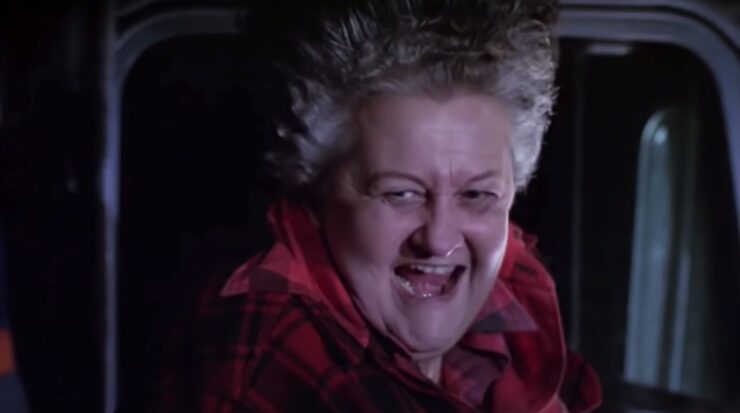
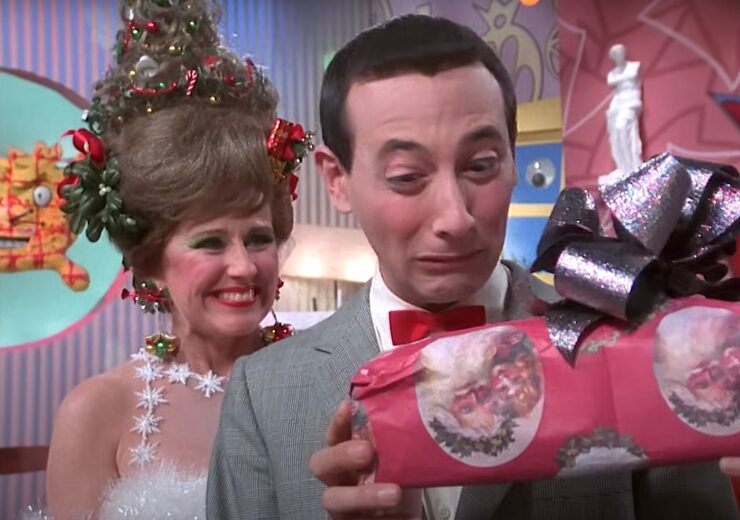

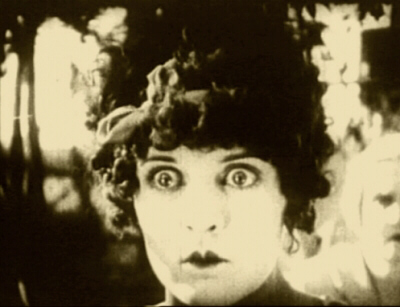
After reading this I’m reminded of the end scene from UHF where Milo says goodbye, his face changes where only the audience can see, then flies off into space to rejoin his people. Prior to this he was simply a strange but harmless person who knew a lot of science. Who didn’t want to to know how to make plutonium from common household items? 10-year old me certainly wanted to know.
When I heard Paul Reubens died, of course one thing came to mind before the rest. Before I thought of the Playhouse or Buffy or anything else, I thought of Large Marge. Thank you for writing about this scene.
The actress who played her was only 60 when she died, though not in a trucking accident.
RIP Alice Nunn and RIP Paul Reubens.
Ahhhhh thank you for this! THIS SCENE was the first thing I thought of when I heard about Paul Reuben’s death. So yes, to everything. This was definitely a formative movie for me. This along with stuff like Beetlejuice, maybe, is what fostered my weird side.
The other thing I want to plug is Elfman’s score for this movie which is just fantastic, and is in my soundtrack playlist. Clown Dream might be one of my first real instances of child me grokking what the point of a soundtrack is, if that makes sense. Like, I don’t know that I had words to articulate it in that way, but it was the music that stood out to me in that scene, and the music that scared me, and the music that stayed in my head. The music itself was a vital part of the scene. I spend a lot of time listening to (and sometimes analyzing) soundtracks and how they can be used for musical storytelling and mood, and while I’m mostly a Williams fan girl, this might actually be my ‘first’ soundtrack that was a thing I actively recognized as opposed to just ‘music that plays in the background’.
The dream sequence with the clown-bicycle surgery and the claymation T-Rex freaked me out as a kid.
Really well written!!
Excellent! Really smart and well-written. Paul/Pee-Wee was a genius.